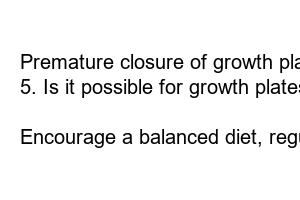성장판 닫히는 시기
As children grow, their bones go through a process of development that involves the growth plates. These growth plates are areas of cartilage near the ends of long bones where growth occurs. They are responsible for the lengthening and shaping of bones during childhood and adolescence. However, at a certain point, these growth plates close, signaling the end of the bone growth process.
**Understanding Growth Plates**
Growth plates are the key players in the bone growth process. They are softer and more vulnerable to injury than mature bones. As children age, the growth plates gradually harden and eventually turn into solid bone. This process typically occurs in the late teens to early twenties.
**How Growth Plates Close**
When growth plates close, it means that the cartilage has turned into bone, and bone growth stops. This closure process usually happens at different times for different bones in the body. The closure of growth plates is typically signaled by the fusion of the bones at the ends.
**Factors Affecting Growth Plate Closure**
Several factors can influence the timing of growth plate closure. Genetics, nutrition, hormones, and physical activity all play a role in determining when growth plates close. Hormones such as estrogen and testosterone have a significant impact on the closure of growth plates.
**Implications of Growth Plate Closure**
Once the growth plates close, bone growth is complete, and the bones reach their maximum length. This is why it is crucial for children and teenagers to receive proper nutrition and physical activity to support healthy bone development before growth plates close.
**What Happens if Growth Plates Close Early or Late**
In some cases, growth plates may close earlier or later than expected, leading to potential complications. Early closure can result in stunted growth or uneven bone lengths, while late closure may indicate delayed growth or other underlying health issues that need to be addressed.
**Monitoring Growth Plate Closure**
Healthcare providers may monitor the closure of growth plates through imaging tests, such as x-rays, to track bone development and ensure that it is progressing as expected. Regular check-ups with a pediatrician or orthopedic specialist can help to assess growth plate closure and address any concerns promptly.
**Summary**
Understanding the process of growth plate closure is essential for ensuring healthy bone development in children and teenagers. As growth plates close, bone growth stops, and the bones reach their maximum length. Factors such as genetics, nutrition, hormones, and physical activity can influence the timing of growth plate closure, highlighting the importance of proper care and monitoring throughout childhood and adolescence.
**FAQs About Growth Plate Closure**
1. Can growth plates reopen after they have closed?
No, once growth plates have closed, they do not reopen.
2. Are there any warning signs that growth plates are closing?
There are no specific warning signs, but healthcare providers can monitor growth plate closure through imaging tests.
3. How can I support healthy bone development in children?
Proper nutrition, physical activity, and regular check-ups with a pediatrician or orthopedic specialist can support healthy bone development.
4. What happens if growth plates close prematurely?
Premature closure of growth plates can result in stunted growth or uneven bone lengths.
5. Is it possible for growth plates to close later than expected?
Yes, growth plates may close later than expected, indicating delayed growth or other underlying health issues.
6. How can I ensure proper bone development before growth plates close?
Encourage a balanced diet, regular exercise, and adequate rest to support healthy bone development before growth plates close.

